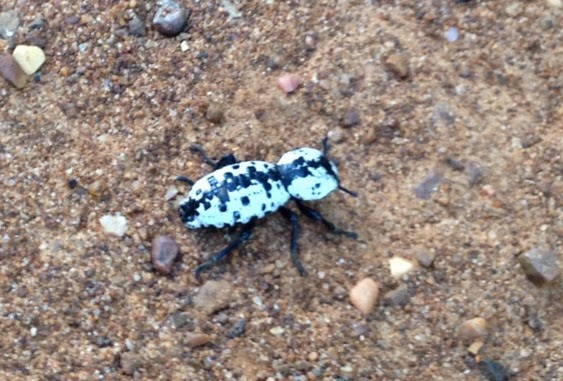The 2014 BioBlitz at Lick Creek Park has come and gone! I was a member of the bird survey team this
year. Other participating TMNers (for the Bird group) were: Jim and Kitty Anding, Katherine Cupps (and her
husband John), Jackie Girouard, Rick Laughlin, Mark McDermott, and Bruce
Neville. We started a survey on Friday
night at about 7 pm at the Chimney Swift Tower.
It was nice and cool with cloudy skies.
We first heard a Black and White Warbler singing loudly nearby.
 |
| Friday Night Bird Survey, Waiting for the rest of the group to show up... and the birds are here, too! From Left to Right: John Cupps, Bruce Neville, Katherine Cupps, and Rick Laughlin. |
As we were waiting for the whole group to
show up, about 40 Mississippi Kites flew over or near us prompting several
clever remakes about the “Mississippi River” or “it’s a good day to fly a
kite!” (By the way, a “river” used by birders refers to a stream of raptors
flying overhead so “Mississippi River” is just really funny...ok, ok, it's a dorky birder joke). Our goal with a night survey was to document
evening and night birds like owls.
Although I’ve heard Barred Owls and Eastern Screech-Owls in the park
before, they apparently didn’t get the memo to come out for us. But we did get a fairly common night bird, a
Chuck-will’s-widow (heard only). The
night walk wasn’t only about birds. It’s
hard to ignore the other night critters in the park (besides the children running
around looking for bats and insects)!
Our first non-bird sighting was an Ironclad Beetle, so named for its extremely
hard exoskeleton. We also saw a Ground Skink crawling along the edge of the trail.
Actually, trail edges were a popular place for a lot of critters. There were many Gulf Coast Toads hopping
along and while I’m not a big fan of spiders, I appreciated a sight of a Wolf Spider
carrying her young on her back.
 |
| Ironclad Beetle on Iron Bridge Trail, Lick Creek Park. |
The bird survey began again bright and early at 7am. We divided ourselves into 4 groups, each
covering a different trail. Rick and I
headed down Iron Bridge Trail and were treated to excellent views of a KentuckyWarbler, Swainson’s Warblers, Black-throated Green Warblers, Yellow-breasted Chat, and a singing Northern Waterthrush.
Every bird group had something interesting to report. Along Raccoon Run Trail a small flock of
Baltimore Orioles were mobbing a Barred Owl and a Northern Bobwhite was spotted along Post Oak Trail.
Besides our birds, at the southern end of Iron Bridge Trail Rick and I
came across a good-sized Box Turtle. He
was one of several we would see throughout the rest of the day… the others
having been caught by the Herpetology survey team (they were released during
the course of the day).
 |
| Box Turtle on Iron Bridge Trail, Lick Creek Park. |
Ok, now it was booth and kid activity time! I spent the morning at the Rio Brazos Audubon
table. Kids and parents trickled in. We had the bird board, which is always a hit,
and nest and egg displays. In the afternoon
I switched to the TMN booth. Barb and
Jay Pritchard had their mammal footprint cast and stencil activity for the
kids. Other TMNers helping out at BioBlitz were: Jim
Balthrop, Dwight Bohlmeyer, Joyce Conner, Terry Junek, Cheryl Lewis, Greg
Pitts, and Michael Stecher.
 |
| The TMN Booth! From Left to Right: Me, Greg Pitts, Jim Balthrop and Cheryl Lewis. Photo by Joyce Conner. |
 |
| TMN Booth with visitors! From Left to Right: Jim Balthrop, Greg Pitts (blocked) and Barb Pritchard. Photo by Joyce Conner. |
 |
| TMN Booth with more visitors! From Left to Right: Greg Pitts, Jim Balthrop, and Cheryl Lewis. Photo by Joyce Conner. |
Overall, it was a great outreach day! Kids went home happy, hopefully gaining some knowledge of the native critters in the park. Volunteers went home happy knowing we made some connections to park visitors. Thanks to everyone who showed up to help! I went home happy having seen some first of season birds (Mississippi Kites!) and having made a friend with a shy box turtle (ok, I know I’m not his friend but he’s mine!) and delighted in the knowledge that the park will soon be full of baby Wolf Spiders crawling around…. Ok, ok, I’ll stop there before I creep myself out any more! Besides, the Skinks have to eat something! All in all, it was a good day to be outside. J
Did you go to BioBlitz? Do you have any interesting sightings or stories? Please share them in the Comments section!











